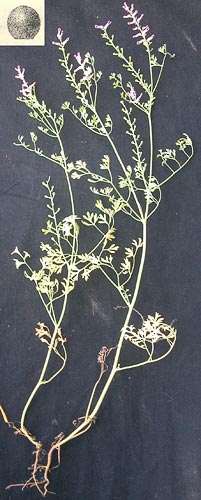Weeds
Fumaria vaillantii Loisel. - Few-flowered fumitory.
Systematic position.
Family Fumariaceae DC., genus Fumaria L.Biological group.
Annual germiniparous weed.Morphology and biology.
Stem is up to 5-30 cm, erect or spreading prostrate, ramified, slightly grooved. Leaves are tripinnatisect, their lobes are linear or filiform. Racemes are located on short plumpish pedicles, few-flowered, dense, not protruding out of leaves. Fruit stalks are plumpish, short, about 2 mm long. Bracts are approximately equal in length to fruit stalks or to 1.5 times shorter. Sepals are very small, about 0.5 mm long, narrower than corolla. Corolla is rose-violet, 5-6 mm long. Upper petal with wide margins on each side of green keel, sharply sinuate at the tip; lower petal is widened in fore part, rounded or slightly sinuate at the tip. Nutlets are shrunken, with a clearly expressed keel, rounded, tuberous-rugged, brownish-green. Shoots emerge in late autumn, in winter or early spring. Flowering period is April-May, fruiting period is May-June.Distribution.
Western Europe, the Mediterranean area, Asia Minor, Iran, the Himalayas. European part of the former USSR, the Caucasus, Crimea, Central Asia, Western Siberia.Ecology.
Grows on dry soils and sands in forest-steppe, steppe, semi-desert and desert zones.Economic significance.
Infests grain crops, occurs in kitchen gardens, vineyards, along field margins, roads and irrigation ditches, on waste lands, near habitations. Control measures include removing the stubble, pre-winter plowing, chemical weeding.Related references:
Keller B.A., Lyubimenko V.N., Maltsev A.I. et al., eds. 1934. Weed plants of the USSR. Leningrad: AN SSSR. V. 3: 24. (In Russian)Nikitin V.V. 1983. Weed plants of the USSR flora. Leningrad: Nauka. 196 p. (In Russian)
Shishkin B.K., ed. 1937. Flora of the USSR. Moscow-Leningrad: AN SSSR. V. 7: 715. (In Russian)


